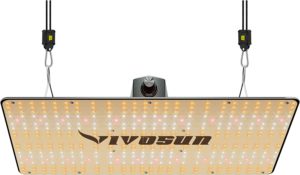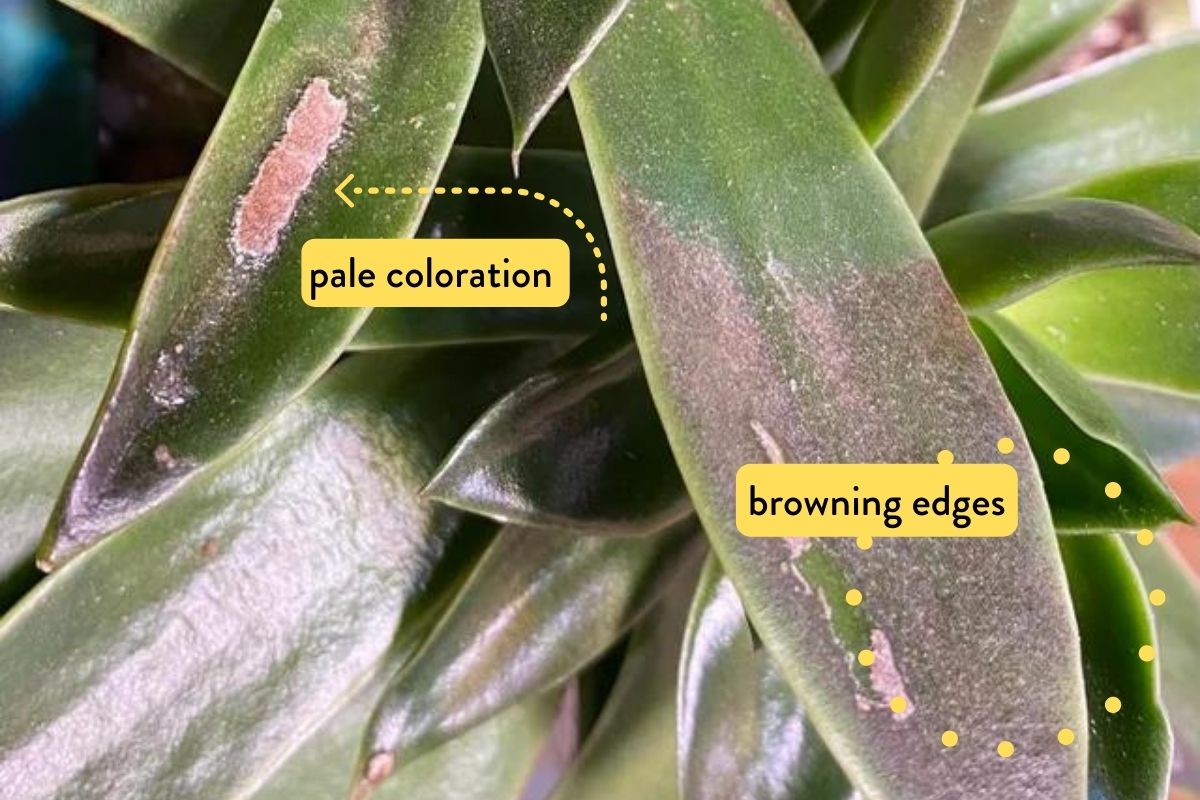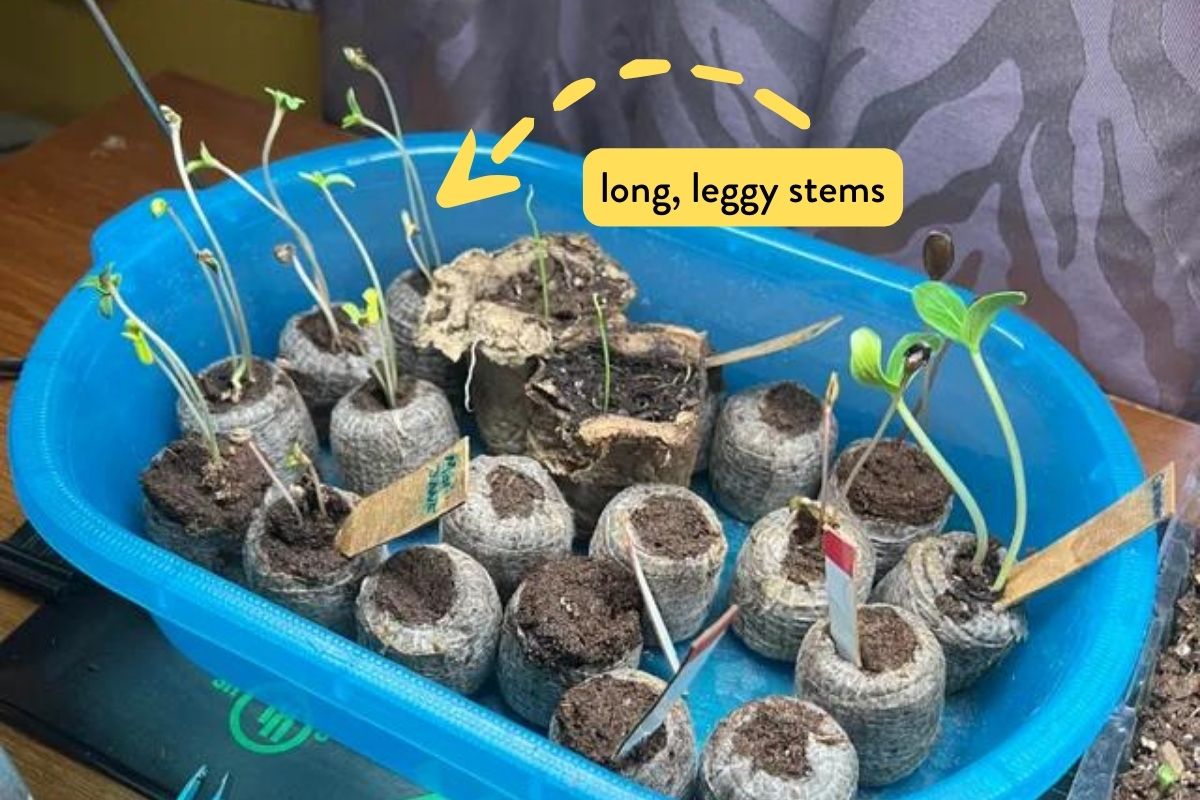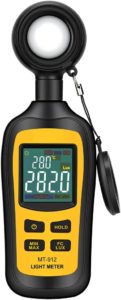The distance of the light from your plants makes a difference in how effective, ineffective, or harmful it may be to your plant.
When light sources are further away, they’re less intense than when they’re close up, meaning less light energy is being issued directly to the plants.
It also means that lamps, when they get close, are much more intense, and too much light at once can damage the plants’ leaves and stems.
So, how do you find that sweet spot and figure out the right distance between your plants and your grow lights?
Lots of variables go into what the right grow light distance is for your situation. Keeping an eye on the plant to monitor its condition and responsiveness to the different light intensity is the best way to inform which, if any, adjustments need to be made.
I’ll walk you through what you need to know to find the optimal distance for your indoor plants this season.
Grow light placement
Since we can grow many plants indoors in homes and greenhouses, there are lots of different lighting setups. Generally, grow lights are suspended above the plant, integrated into a tray shelving unit, or in a free-standing lamp.
While these setups may be different for your purpose and situation, it is still possible to cause some major damage by getting this grow light distance wrong.If a lamp is too close to a plant, then it can burn or bleach the leaves. And if the light bulb is too far, then it won’t emit enough light energy. This will cause small or few flowers or fruits, leggy stems, small and sparse leaves, and slow plant growth.
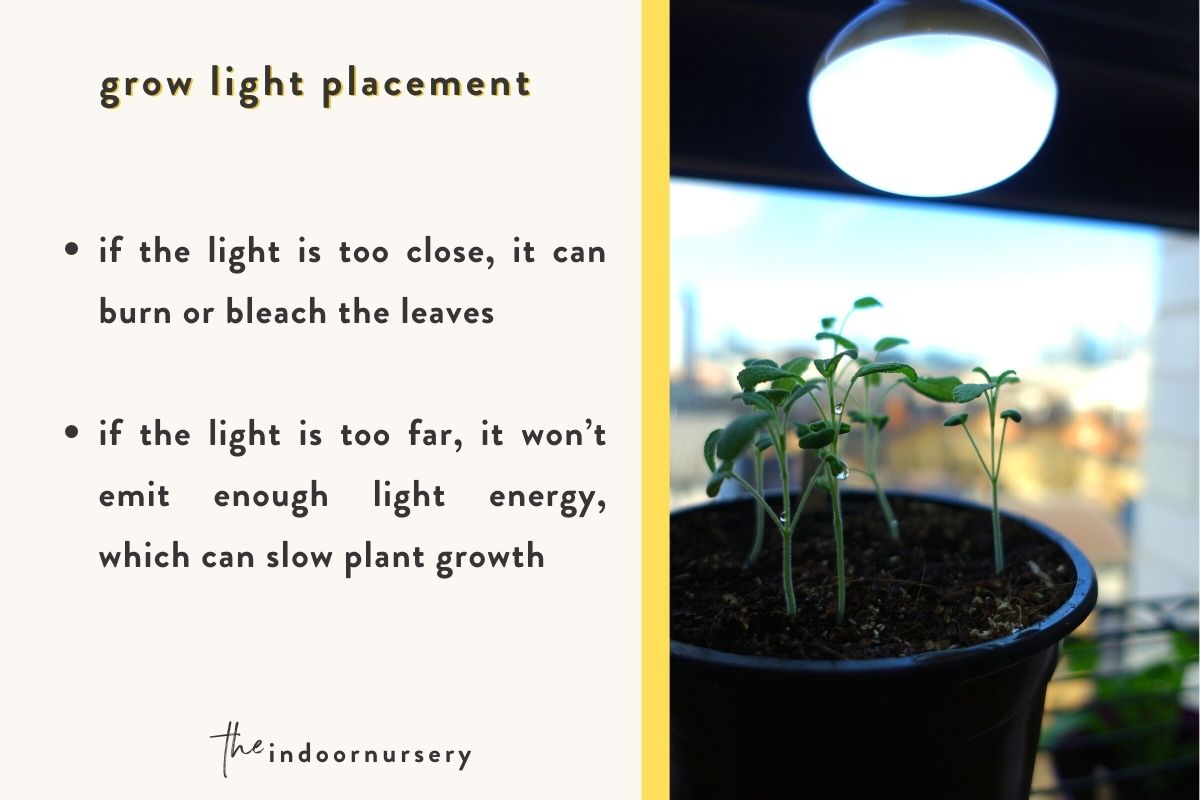
I’ll get more into that later. For now, let’s jump into other factors to consider when finding the proper distance for your plants.
Light bulb intensity
Like regular light bulbs, grow lights come in different lumens—the measure of radiant light output and intensity—which makes a difference in how effective they will be at different distances from the plants. Most manufacturers provide a grow light distance chart that shows the intensity and area coverage at certain suspended heights.
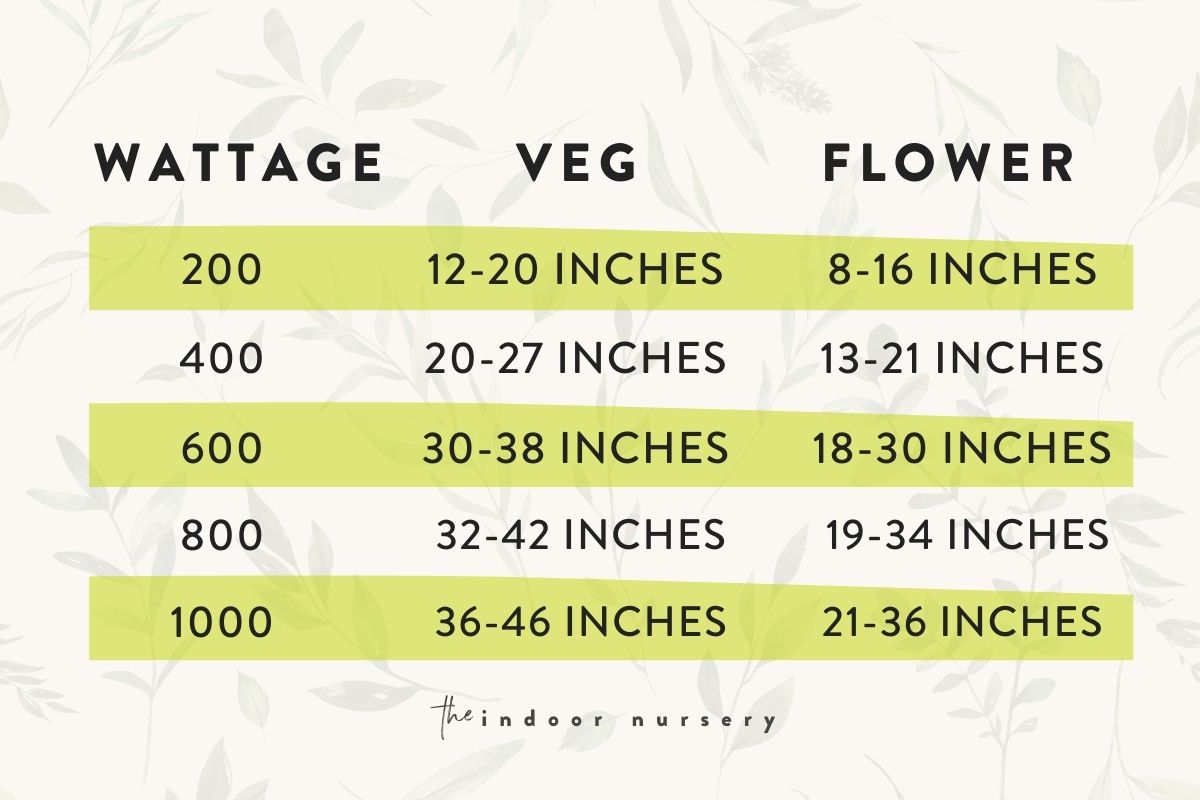
The intensity of a light bulb can be adjusted
- by moving it closer or further from the plant,
- by using a dimmer,
- or by using (or not using) a shade or cover to focus the light’s dispersal.
The wattage of the bulb is the amount of energy needed to emit light, but the actual lumens issued by the bulb will vary by the way it produces light. This means wattages between lightbulb types, like incandescent and LED, don’t translate to one another in terms of light intensity.
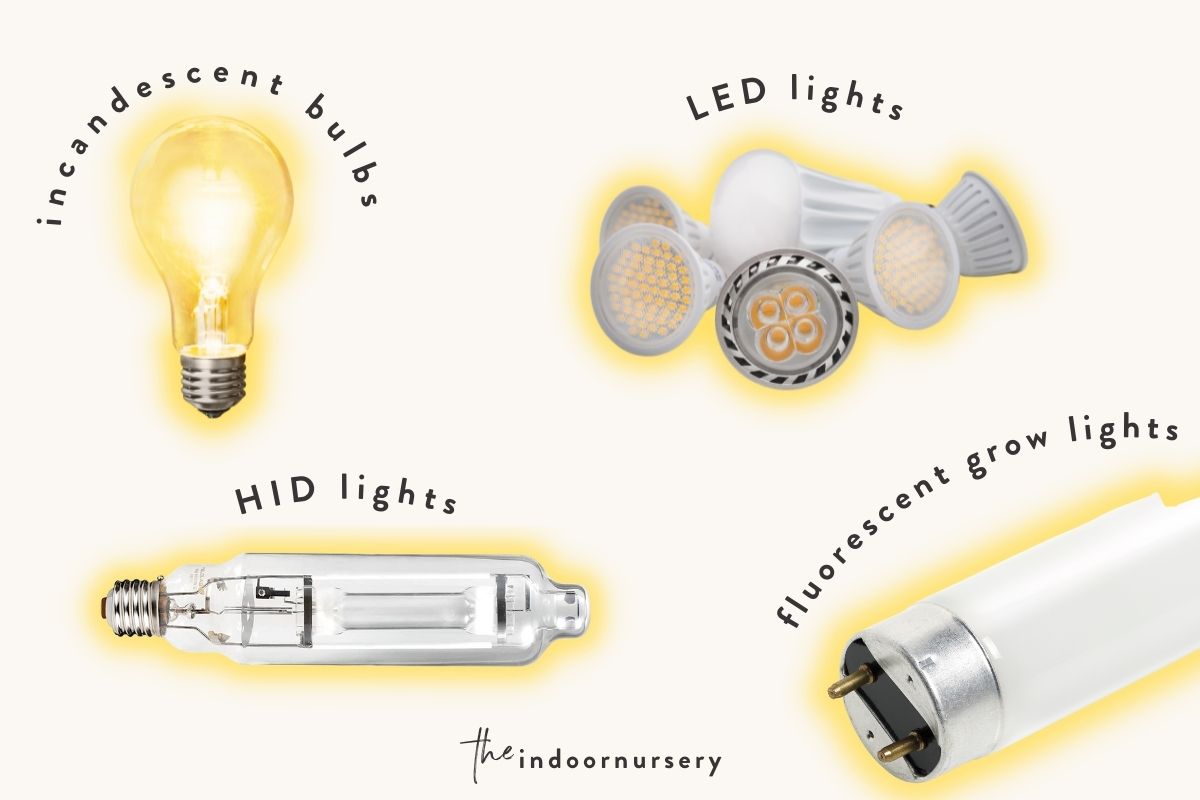
Incandescent bulbs
This is the classic light bulb that contains a filament that heats up until it glows. It’s the most energy intensive type of light bulb, and while we can use it as a grow light, it doesn’t produce the full spectrum of light needed for plants to survive on. These traditional lights give off mostly red light wavelengths and can be most helpful with fruiting and flowering plants. These also give off the most heat, so we should keep them at a distance from any foliage.
LED grow lights
An LED grow light (light-emitting diode) bulb has a microchip system that emits visible light, which can be programmed to different colors or the full spectrum. This makes LED lights an ideal choice for any indoor growing need, and they are much more efficient in their power usage: these bulbs use up to 90% less power.
Their technology makes LED grow lights more expensive than other bulbs, but they last much longer than other ones, too. LED lighting produces some heat energy, but not as much as an incandescent light bulb.
Fluorescent grow lights
Fluorescent, or compact fluorescent (CFL) lights are another popular, energy efficient choice for home growers. Fluorescent lamps don’t use a filament like incandescent bulbs, but they are filled with argon gas, a little mercury, and phosphorus-coated glass, that illuminates with an electric current. They use about 75% less energy than incandescent bulbs, producing more lumens per watt (although fewer than LED bulbs). Fluorescent grow lights give off a low level of heat and can be found in red, blue, or full spectrum options.
HID grow lights
HID, or high-intensity discharge, lights, are like fluorescent ones in that they are made with elemental gasses that illuminate with an electric current, giving off a full spectrum of light. These high-intensity discharge lights give off little heat and are very energy efficient, but they are expensive and normally used by commercial growers.
Light dispersion
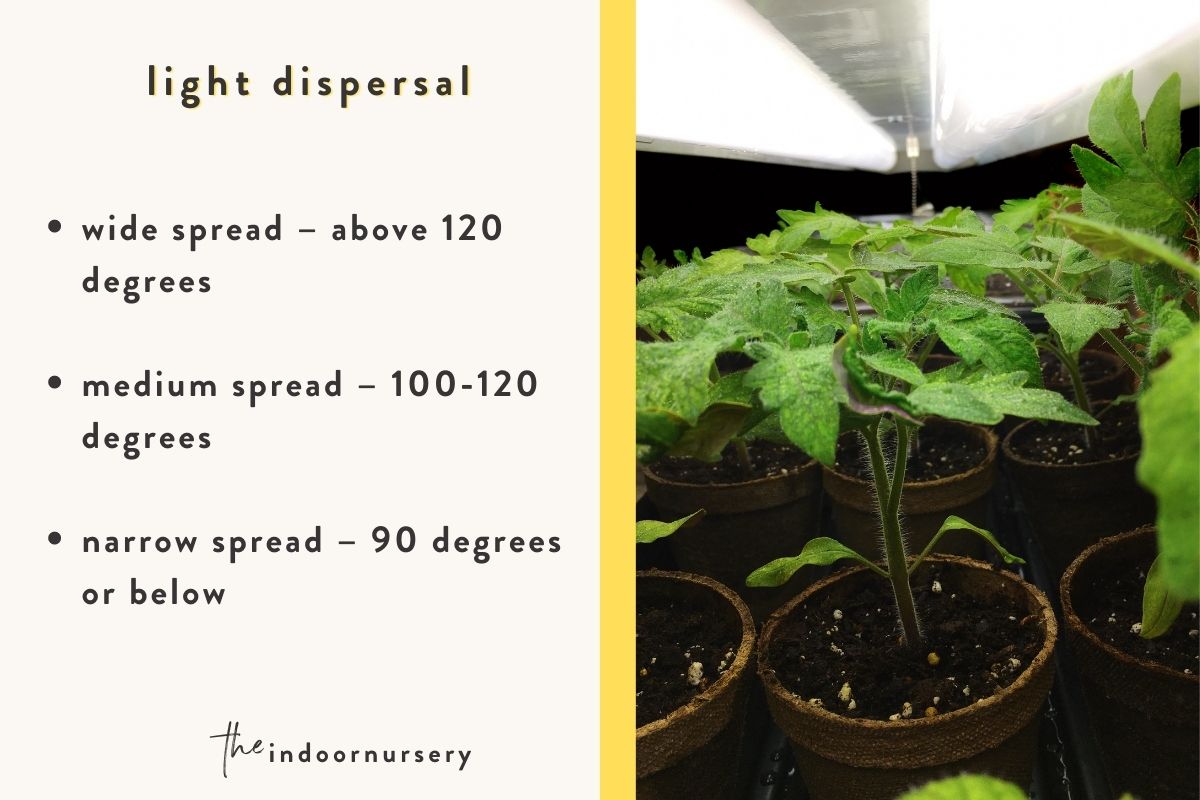
The way they disperse the light is another factor in deciding just how close grow lights should be to plants, or how far a light bulb should be positioned from your indoor plants. When lights are focused, or unfocused, they disperse light differently.
A bulb with a hood or shade blocks light from being emitted in some directions and focuses the spread of it into a concentrated flow for efficient use by the plants underneath or nearby. A light’s spread is broken down in three ways:
- Widespread—above 120 degrees
- Medium spread—100-120 degrees
- Narrow spread—90 degrees or below
Most grow lights will have a widespread so they can cast as much light below them as possible, whereas narrow spread grow lights focus the light spread and keep increasing light intensity like a spotlight. A widespread can usually be closer to a plant than one with a narrow spread, which might focus too much energy on the leaves.
The lumens (total light radiation) of light emitted won’t be affected by the spread, but the lux (the area coverage of the light) may be adjusted by widening or narrowing the light dispersal.
Where should grow lights be located?
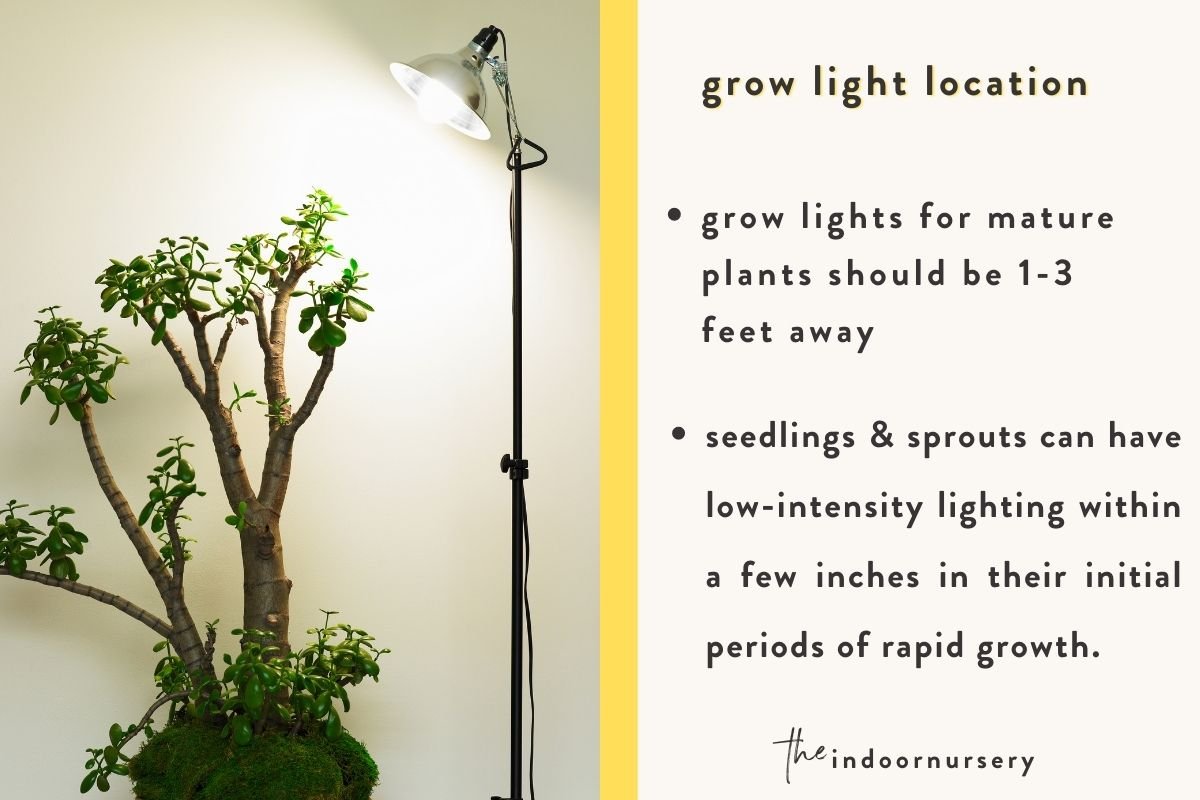
In general, grow lights for mature plants should be 1-3 feet away, although seedlings and sprouts can tolerate low-intensity lighting within a few inches in their initial periods of rapid growth.
If your plant is in a reflective grow space, like in an indoor grow tent, then higher is better for the light to be better reflected by the walls to reach the lower stems and leaves. A narrowly focused light may need to be set further away than a widespread light to make sure to not burn the leaves.
Generally speaking, an LED or CFL light can be closer than an incandescent light.
All of that being said, it’s helpful to consider the specific light needs of your plant. Some plants, like succulents and cacti, need very bright, direct light in order to thrive. For these types of plants, you’ll want to position your grow light very close to the plant. For most succulents, it is recommended to position the grow light about 6-12 inches away from the plant, but this may vary depending on the specific species and the intensity of the light.
Other plants, like herbs and leafy greens, need less intense light and can be positioned further away from the grow light. A good rule of thumb for these types of plants is to position the light about 12-18 inches away from the plant.
It’s also important to consider the light spectrum when positioning your grow light. Different plants have different light spectrum needs, so it’s a good idea to choose a grow light that is specifically designed for the type of plant you’re growing.
For example, plants that are in the vegetative stage of growth (like leafy greens) need a grow light with a higher ratio of blue light, while plants in the flowering stage (like tomatoes) need more red light.
If you’re growing a variety of different plants, you might use multiple grow lights with different spectrums so that each plant gets the specific type of light it needs.
Always consult the directions provided by the manufacturer should give you the specifics for the intensity and model of light you’ve chosen, monitor the plant(s), and adjust as necessary.
Signs a grow light is too close to a plant
If your grow lights are too close to your plants, they will show some telltale signs of overexposure, much the same as they would if placed in direct sunlight for too long. These include:
- Browning edges or burnt spots
- Curling or wrinkling
- Drying out
- Pale or whitish coloration
Signs a grow light is too far from a plant
When plants aren’t getting enough light, either from too little sunlight or grow lamps that are too far away or too weak, they’ll show the following signs:
- Long, leggy stems
- Small and sparse leaf growth
- Pale or whitish coloration
Monitoring your grow light’s distance and effectiveness
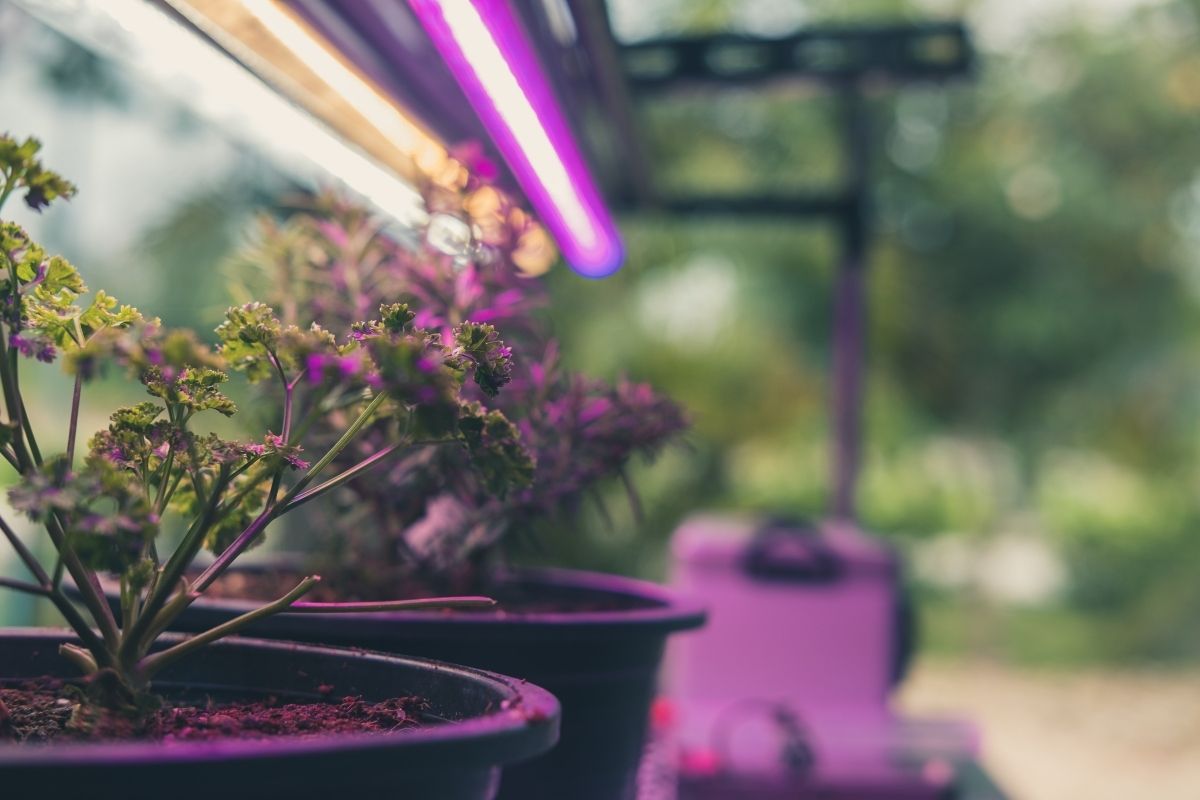
While these rules of thumb and the manufacturer’s directions are important guidelines for positioning your plants and using grow lights, regular monitoring of the plants’ conditions will be your best way of knowing if the plant is getting enough light. Since plants have different lighting needs by species, the right setup may depend on the plant itself as much as the position of the light source.
What’s too close or too far for some may be the right setting for others. Knowing your plant’s origins and lighting needs in the first place will be another important guideline in figuring out how much more light exposure your plant needs, in terms of time and intensity.
Once you understand your plant’s needs, then you can start measuring your grow light output with a PAR meter.
PAR meters are specialized tools used to measure the intensity of light in the PAR (photosynthetically active radiation) range, which is the range of light that plants use for photosynthesis. These devices work by measuring the amount of light that falls within the PAR range and giving a reading in micromoles per square meter per second (μmol/m2/s).
To use a PAR meter, simply turn it on and place it in the location where you want to measure the light intensity. The meter will give you a reading in μmol/m2/s, which you can use to determine whether your plants are getting enough light or whether you need to adjust the positioning or intensity of your grow lights.
If you don’t have access to a PAR meter, there are other ways to estimate the light intensity of your grow lights. One common method is to use a lux meter, which measures the total amount of visible light in a given area. While lux meters are not as accurate as PAR meters for measuring the intensity of light in the PAR range, they can still be useful for getting a general sense of the light intensity in your grow space.
Another option is to use a smartphone app that measures light intensity. There are several free or low-cost apps available that use the camera on your phone to measure light intensity, although these may not be as accurate as dedicated light meters.
Common Problems/FAQs
How many lights do I need for my indoor plants?
The number of light bulbs will affect the intensity of all the light your plants are getting: too many bulbs too close will damage the plants, while many lights too far may not be enough. Large growing operations will use many light fixtures at specific distances to make sure the large number of plants in various growing stages are receiving the amount of light each individual needs with no light burn, while your houseplants at home may be happy with one or two extra lights for those darker days and evenings.
How do I know how much light my plants are getting?
The best way to know if a light is too close or too far is to measure the intensity with a PAR meter. PAR stands for photosynthetically active radiation, referring to the amount of light that a plant can use for photosynthesis. A PAR meter is used to know how much light is reaching a certain spot. This is useful since lumens measure the amount of light issued, but not how much is being used by the plant, while lux refers to the total amount of space covered by a light. The PAR measurement, in micromoles, lets you know how much light is reaching a given location, like a leaf. PAR meters display in the 400-700 visible light range, and some extend to a wider 340-1040 light range, which includes infrared and other invisible light radiation.
More about lighting
- How To Use Grow Lights For Indoor Plants
- 5 Best Grow Light Strips For Indoor Plants
- Our *hands on* MARS HYDRO TSW 2000 review (with photos)
- Understanding weed light cycles: Get the most from your harvest
- Indoor plant lighting guide: where to put your plants
- How close should grow lights be to plants?
- Best grow lights for seedlings: how to sprout your seedlings safely
- Guide: full-spectrum light for plants (+grow light spectrum chart)
- 10 best LED grow lights for indoor plants
- Tags:
- grow lights
- plant care


